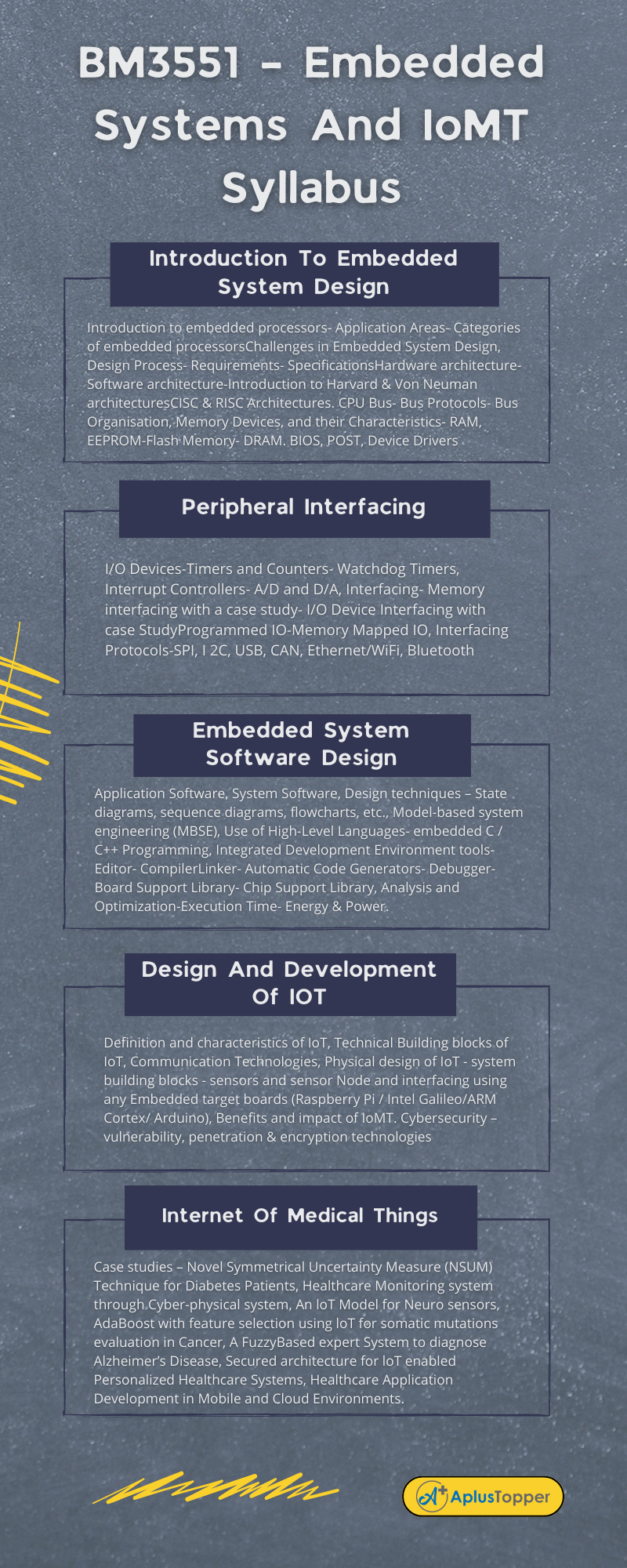In this article, we are going to discuss the B.E. Biomedical Engineering, semester V, Anna University connected to the regulation 2021 subject syllabus. Let’s see what’s more…
We tried our best to provide the following unit-wise BM3551 – Embedded Systems And IoMT detailed Syllabus. We sum up the appropriate textbooks and references to this page. If you have any doubts regarding the syllabus, you can simply comment below on the following page. Hope this information is useful. Share it with your classmates. Thanks for landing on this page.
If you want to know more about the B.E. Biomedical Engineering Syllabus connected to an affiliated institution’s four-year undergraduate degree program. We provide you with a detailed Year-wise, semester-wise, and Subject-wise syllabus in the following link B.E. Biomedical Engineering Syllabus Regulation 2021 Anna University.
Aim of Concept:
The objective of this course is to enable the student to
- Acquire knowledge and understand fundamental embedded systems design paradigms, architectures, possibilities, and challenges, both with respect to software and hardware.
- Understand the hardware architecture and features of embedded microcontrollers and peripherals.
- Understand programming aspects of embedded system design.
- Understand IoT architecture and Build simple IoT Systems using embedded target boards.
- Understand IoMT infrastructure for healthcare applications.
BM3551 – Embedded Systems And IoMT Syllabus
Unit I: Introduction To Embedded System Design
Introduction to embedded processors- Application Areas- Categories of embedded processorsChallenges in Embedded System Design, Design Process- Requirements- SpecificationsHardware architecture- Software architecture-Introduction to Harvard & Von Neuman architecturesCISC & RISC Architectures. CPU Bus- Bus Protocols- Bus Organisation, Memory Devices, and their Characteristics- RAM, EEPROM-Flash Memory- DRAM. BIOS, POST, Device Drivers
Unit II: Peripheral Interfacing
I/O Devices-Timers and Counters- Watchdog Timers, Interrupt Controllers- A/D and D/A, Interfacing- Memory interfacing with a case study- I/O Device Interfacing with case StudyProgrammed IO-Memory Mapped IO, Interfacing Protocols-SPI, I 2C, USB, CAN, Ethernet/WiFi, Bluetooth
Unit III: Embedded System Software Design
Application Software, System Software, Design techniques – State diagrams, sequence diagrams, flowcharts, etc., Model-based system engineering (MBSE), Use of High-Level Languages- embedded C / C++ Programming, Integrated Development Environment tools- Editor- CompilerLinker- Automatic Code Generators- Debugger- Board Support Library- Chip Support Library, Analysis and Optimization-Execution Time- Energy & Power.
Unit IV: Design And Development Of IOT
Definition and characteristics of IoT, Technical Building blocks of IoT, Communication Technologies, Physical design of IoT – system building blocks – sensors and sensor Node and interfacing using any Embedded target boards (Raspberry Pi / Intel Galileo/ARM Cortex/ Arduino), Benefits and impact of IoMT. Cybersecurity – vulnerability, penetration & encryption technologies

Unit V: Internet Of Medical Things
Case studies – Novel Symmetrical Uncertainty Measure (NSUM) Technique for Diabetes Patients, Healthcare Monitoring system through Cyber-physical system, An loT Model for Neuro sensors, AdaBoost with feature selection using loT for somatic mutations evaluation in Cancer, A FuzzyBased expert System to diagnose Alzheimer’s Disease, Secured architecture for loT enabled Personalized Healthcare Systems, Healthcare Application Development in Mobile and Cloud Environments.
Text Books:
- Embedded Systems – A Contemporary Design Tool, James K Peckol, , John Weily, 2008, ISBN: 0- 444-51616-6.
- David Hanes, Gonzalo Salgueiro, Patrick Grossetete, Rob Barton and Jerome Henry, “loT Fundamentals: Networking Technologies, Protocols and Use Cases for lnternet of Things, Cisco Press, 2017.
- Venkata Krishna, Sasikumar Gurumoorthy, Mohammad S. Obaidat, “lnternet of Things and Personalized Healthcare Systems”, Springer Briefs in Applied Sciences, and Technology, Forensic and Medical Bioinformatics, 2019.
Reference Books:
- Introduction to Embedded Systems, Shibu K V, Tata McGraw Hill Education Private Limited, 2009, ISBN: 10: 0070678790 3.
- Embedded Software Primer, David E.Simon, ,Addison Wesley, ISBN-13: 978-0201615692
- The Intel Microprocessors, Architecture, Programming and Interfacing” Barry B.Brey, 6th Edition, Pearson Education.
- Arshdeep Bahga, Vijay Madisetti, “lnternet of Things – A hands-on approach”, Universities Press, 2015
- Olivier Hersent, David Boswarthick, Omar Elloumi, “The Internet of Things – Key applications and Protocols”, Wiley, 2012.
- Jan Holler, Vlasios Tsiatsis, Catherine Mulligan, Stamatis, Karnouskos, Stefan Avesand. David Boyle, “From Machine-to-Machine to the Internet of Things – Introduction to a New Age of Intelligence”, Elsevier, 2014.
- Dieter Uckelmann, Mark Harrison, Michahelles, Florian (Eds), “Architecting the Internet of Things”, Springer, 2011.
- Michael Margolis, Arduino Cookbook, “Recipes to Begin, Expand, and Enhance Your Projects”, OReilly Media, 2nd Edition.
Related Posts On Semester – V:
- BM3591 Diagnostic and Therapeutic Equipment
- BM3562 Embedded Systems and IOMT Laboratory
- BM3561 Diagnostic and Therapeutic Equipment Laboratory
Must Read:
